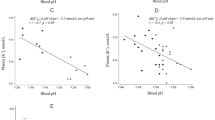Abstract
The Na+/H+ antiport is a membrane transport protein that extrudes intracellular protons in exchange for extracellular sodium. Some details of its physiological and pathophysiological role remain poorly defined. Experimental evidence suggests that the antiporter is involved in the regulation of cell volume. In the present study, we therefore investigated the activity of the lymphocyte Na+/H+ antiport in nine healthy volunteers following acute hypertonic (2.5%) saline infusion (4 mmol NaCl/kg over 120 min). Antiport activity was measured after acidifying the cells with Na+ propionate (5–40 mM) using the fluorescent dye bis-carboxyethyl carboxyfluorescein. Hypertonic saline induced significant increases in plasma osmolality (308.4±2.3 vs. 293.5±2.7 mOsm/kg; P<0.01), serum Na+ (150.8±3.7 vs. 138.9±0.5 mmol/kg; P<0.01), and Cl− concentrations (118.0±3.9 vs. 101.1±1.0 mmol/kg; P<0.01). Extracellular hypertonicity was followed by a stimulated activity of the lymphocyte Na+/H+ antiport with an increase in the apparent V max values from 2.44±0.16 to 3.27±0.34 10−3 s−1 (P<0.01) and a slight rise in pK from 6.81±0.03 to 6.87±0.03 (P<0.05) after hypertonic saline. In addition to antiport activation, cytosolic alkalinization was observed with cytosolic pH values averaging 6.90±0.02 before and 6.99±0.02 (P<0.01) after hypertonic saline. Our results show for the first time that acute extracellular hypertonicity in man due to hypertonic NaCl loading is associated with a stimulated lymphocyte Na+/H+ antiport activity and cytosolic alkalinization.
Similar content being viewed by others
Abbreviations
- BCECF-AM:
-
bis-carboxyethyl carboxyfluorescein, acetoxymethyl ester
- HEPES:
-
4-(2-hydroxyethyl)-1-piperazine ethane sulfonic acid
References
Arieff AI, Carroll JH (1972) Nonketotic hyperosmolar coma with hyperglycemia. Clinical features, pathophysiology, renal function, acid-base balance, plasma cerebrospinal equilibria and effects of therapy in 37 cases. Medicine (Baltimore) 51:73
Counillon L, Pouyssegur J (1992) Structure, function and growth factor activation of the Na+/H+ antiporter (NHE1). Cell Physiol Biochem 2:138–149
Düsing R, Göbel BO, Leibhammer S, Hoffmann G, Siffert W, Vetter H (1992) The effects of isotonic and hypertonic saline infusion on lymphocyte Na+/H+ antiport activity in healthy human subjects. J Am Soc Nephrol 3:806
Garella S, Tzamaloukas AH, Chazan JA (1973) Effect of isotonic volume expansion on extracellular bicarbonate stores in normal dogs. Am J Physiol 225:628–636
Garella S, Chang BS, Kahn SI (1975) Dilution acidosis and contraction alkalosis: review of a concept. Kidney Int 8:279–283
Göbel BO, Hoffmann G, Ruppert M, Stumpe KO, Vetter H, Düsing R (1991) Membrane transport, sodium balance, and blood pressure regulation. Klin Wochenschr 69 [Suppl XXV]:84–89
Göbel B, Hoffmann G, Ruppert M, Stumpe KO, Siffert W, Düsing R (1994) The lymphocyte Na+/H+ antiport in primary hypertension and during chronic NaCl-loading. Eur J Clin Invest (in press)
Grinstein S, Goetz JD, Cohen S, Furuya W, Rothstein A, Gelfand EW (1985) Mechanism of regulatory volume increase in osmotically shrunken lymphocytes. Mol Physiol 8:185–198
Grinstein S, Rothstein A (1986) Mechanisms of regulation of the Na+/H+ exchanger (topical review). J Membr Biol 90:1–12
Grinstein S, Cohen S, Goetz-Smith JD, Dixon SJ (1989) Measurements of cytoplasmic pH and cellular volume for detection of Na+/H+ exchange in lymphocytes. Methods Enzymol 173:777–790
Haber E, Koerner T, Page LB (1969) Application of a radioimmunoassay for angiotensin I to the physiologic measurements of plasma renin activity in normal human subjects. J Clin Endocrinol 29:1349–1357
Makoff DL, DaSilva JO, Rosenbaum BJ, Levy SE, Maxwell MH (1970) Hypertonic expansion: acid-base and electrolyte changes. Am J Physiol 218:1201–1207
Poli de Figueiredo CE, Ng LL, Davis JE, Lucio-Cazana FJ, Ellory JC, Hendry BM (1991) Modulation of a Na+/H+ antiporter activity in human lymphoblasts by altered membrane cholesterol. Am J Physiol 261:C1138-C1142
Reusch HP, Reusch R, Rosskopf D, Siffert W, Mann JFE, Luft FC (1993) Na+/H+ exchange in human lymphocytes and platelets in chronic and subacute metabolic acidosis. J Clin Invest 92:858–865
Reusch HP, Lowe J, Ives HE (1993) Osmotic activation of the Na/H-exchanger in smooth muscle cells and fibroblasts. J Am Soc Nephrol 4:894
Rosenbaum BJ, Makoff DL, Maxwell MH (1969) Acid-base and electrolyte changes induced by acute isotonic saline infusion in the nephrectomized dog. J Lab Clin Med 74:427–435
Rosskopf D, Düsing R, Siffert W (1993) Membrane sodium-proton exchange and primary hypertension. Hypertension 21:607–617
Rothstein A (1989) The Na+/H+ exchange system in cell pH and volume control. Rev Physiol Biochem Pharmacol 112:235–257
Seifter JL, Aronson PS (1986) Properties and physiological roles of the plasma membrane sodium-hydrogen exchanger. J Clin Invest 78:859–864
Tse M, Levine S, Yun C, Brant S, Pouyssegur J, Donowitz M (1993) The mammalian Na+/H+ exchanger gene family —initial structure/function studies. J Am Soc Nephrol 4:969–975
Winters RW, Scaglione PR, Nahas GG, Verosky M (1964) The mechanism of acidosis produced by hyperosmotic infusions. J Clin Invest 43:647–658
Author information
Authors and Affiliations
Rights and permissions
About this article
Cite this article
Düsing, R., Leibhammer, S., Hoffmann, G. et al. Hypertonic saline infusion induces activation of the lymphocyte Na+/H+ antiport and cytosolic alkalinization in healthy human subjects. Clin Investig 72, 817–821 (1994). https://doi.org/10.1007/BF00190734
Received:
Revised:
Accepted:
Issue Date:
DOI: https://doi.org/10.1007/BF00190734



